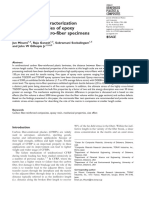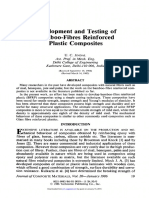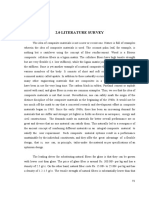Layers of Strength: Simulation Helps Develop Thinner Composite Materials Using Natural Fibers
Layers of Strength: Simulation Helps Develop Thinner Composite Materials Using Natural Fibers
Uploaded by
Vinay KumarCopyright:
Available Formats
Layers of Strength: Simulation Helps Develop Thinner Composite Materials Using Natural Fibers
Layers of Strength: Simulation Helps Develop Thinner Composite Materials Using Natural Fibers
Uploaded by
Vinay KumarOriginal Title
Copyright
Available Formats
Share this document
Did you find this document useful?
Is this content inappropriate?
Copyright:
Available Formats
Layers of Strength: Simulation Helps Develop Thinner Composite Materials Using Natural Fibers
Layers of Strength: Simulation Helps Develop Thinner Composite Materials Using Natural Fibers
Uploaded by
Vinay KumarCopyright:
Available Formats
MATERIALS: COMPOSITES
Layers of Strength
Simulation helps develop thinner composite materials using natural fibers.
By M. Nithiyakumar, Department of Textile Technology, SSM Academy of Textiles & Management, Erode, India D. Gopalakrishnan, South India Institute of Fashion Technology, Coimbatore, India
Fiber-reinforced composites have come a long way in replacing conventional materials like metals and woods. These types of composites are derived by combining fibrous material, which serves as the reinforcing material that primarily carries the load in the composite, with a matrix material, which bonds the fibers together, supports them and is responsible for transferring the load from fiber to fiber. The purpose of combining materials in this manner is to achieve superior properties and performance when compared to the individual materials. As truly engineered materials, designers of composites can select the composition to generate particular performance specifications based on individual application needs. To improve the performance and durability of timber structures specifically, fiber-reinforced polymer (FRP) composites are one option that is increasingly used. Typical FRP composites found in the wood industry are composed of coir-ply boards with oriented jute (as face veneer) or coir combined with waste rubber wood (used as an internal layer). In these materials, phenol formaldehyde is often used as the matrix material. To develop a design that meets the cost, weight and safety requirements for a specific application, a composite materials mechanical properties especially its failure point must be understood. In recent years, computer simulation has emerged as an effective approach for predicting load distribution and failure of composite materials. Since each layer in a composite material may have different orthotropic material properties, special care is
s6
Image iStockphoto/jhorrocks
required in setting up the analysis. This includes choosing the proper element type, defining the layered configurations, and specifying failure criteria and individual layers material properties. Solving fracture mechanics problems computationally involves performing a linear elastic or elasticplastic static analysis and then using specialized post-processing commands or macros to calculate desired fracture parameters. Each of the products in the ANSYS family of mechanical simulation solutions allows for the modeling of composite materials with specialized elements, called layered elements, that support nonlinearities such as large deflection and stress stiffening. To learn more about FRP composites, researchers used these elements in the creation of five finite element (FE) models of varying thickness and layer configurations for analysis. For each model, the tensile stress and deforming behavior were analyzed. Input data such as density, Youngs modulus, shear modulus and Poissons ratio was provided. The coir and
jute, which was impregnated with phenolic resin, were considered as isotropic materials. Wood was considered as an orthotropic material. The simulations were divided into two sets of material combinations. Set 1 included three simulations of FRP composites that were composed of an increasing number of layers of phenolic coir and wood. Set 2 used two of the three compositions from Set 1 but replaced a wooden layer in the composition with a phenolic jute layer. The Youngs modulus of the phenolic coir is only 4.3 GPa, while the modulus value of the wood is as much as 16 GPa in the direction of the grain but only 1 GPa in the direction perpendicular to the grain. The modulus of jute is up to 40 GPa, and that of phenolic jute is 7.5 GPa, which is higher than that of phenolic coir. When deformed, the elongation of the coir is as much as 40 percent, while the elongation for jute is only 1.5 percent. This indicates that the introduction of the phenolic jute
www.ansys.com
ANSYS Advantage Volume I, Issue 4, 2007
MATERIALS: COMPOSITES
layers into the FRP composite should lead to significant improvement in tensile stress values. The simulation results showed that the load was distributed to all the layers and throughout the entire parts. The edges were well gripped and there was no deformation. The deformations were controlled by the composite energy of the material. Even though the layers were individually separate, their movement or tendency for separation was controlled by the adjacent layers. From the results of the simulation, it also appeared that, regardless of composition, the tensile stress gradually increased with thickness. The deflections seen in the models that did not include phenolic jute layers (those in Set 1) were higher than those seen in the equivalent models from Set 2. One thing that was noted was that the thicker of the two models in Set 2 used a thicker phenolic jute layer than the other to replace the wood layer. This was important because it explained what appeared to be a reduction in deflection that occurred with an increase in overall material thickness, which did not otherwise match the trend seen in the data. The thickest composite model from Set 2 was found to have a tensile stress greater than its equivalent case from Set 1, though the deformation was the same. The same model from Set 2
was also found to have tensile strength equivalent to a thicker model from Set 1, but with the same deformation. This meant that, in comparison, the option from Set 2 could provide a decrease in the amount of material used without a significant variation in tensile strength and deformation. Using mechanical simulations and coordinated experimentation, it was concluded that even though the tensile stress values of computational models cannot be accurately compared to the real boards, due to the non-homogeneous nature of the real material, the deformation tendency is the same for both. In this way, mechanical behavior could be correlated. In this study, it was also demonstrated that inclusion of the phenolic jute layers gave composite boards higher stiffness and eliminated the need for one layer of wood in these particular materials. Simulation helped demonstrate that stronger mechanical properties could be obtained at lower thicknesses, leading to benefits such as reduction in cost and weight.
Model 1 (3 layers 6 mm)
Model 2 (5 layers 7 mm)
Model 3 (5 layers 10.5 mm)
References
[1] Nithiyakumar, M.; Gopalakrishnan, D., Development and analysis of jute and coir reinforced composites, www.fibre2fashion.com/industryarticle/1/89/development-and-analysisof-jute-and-coir-reinforcedcomposites1.asp, 2007.
Model
Set
Description
Total Thickness of Model (mm) 6
Max. Stress (Mpa) 90.9
Deflection (mm) 2.14
Model 4 (7 layers 12.5 mm)
M1
3 layers (2 phenolic coir + 1 wood) 5 layers (2 phenolic coir + 1 wood + 2 phenolic jute) 5 layers (3 phenolic coir + 2 wood) 7 layers (3 phenolic coir + 2 wood + 2 phenolic jute) 7 layers (4 phenolic coir + 3 wood)
M2
184
4.3
M3
10.5
215
6.9
M4
12.5
241
3.8 Model 5 (7 layers 15 mm)
M5
15
264
8 Tensile stress for the five models of jute and coir reinforced composites studied
Description of simulation models and results for FEA simulations of FRP composites
www.ansys.com
ANSYS Advantage Volume I, Issue 4, 2007
s7
You might also like
- KKS Power Plant Classification SystemDocument18 pagesKKS Power Plant Classification SystemMR R C CLARKENo ratings yet
- Effects of Fibre Orientation On Mechanical Properties of Hybrid Bamboo/glass Fibre Polymer CompositesDocument6 pagesEffects of Fibre Orientation On Mechanical Properties of Hybrid Bamboo/glass Fibre Polymer CompositesAnish KumarNo ratings yet
- Study On Mechanical Properties of Flax Fiber Reinforced With Different MatricesDocument9 pagesStudy On Mechanical Properties of Flax Fiber Reinforced With Different Matriceskehabtemaryam bayleyegnNo ratings yet
- Bamboo+Alumina CompositeDocument5 pagesBamboo+Alumina CompositeAmmineni Syam PrasadNo ratings yet
- Fiber TestingDocument11 pagesFiber TestingSandy YansikuNo ratings yet
- Rule of Mixture 2Document5 pagesRule of Mixture 2Eric SamNo ratings yet
- Study of The Behaviour of Hybrid Nano Jute Fiber Composite Under Impact LoadsDocument4 pagesStudy of The Behaviour of Hybrid Nano Jute Fiber Composite Under Impact LoadsTJPRC PublicationsNo ratings yet
- Effect of Fiber Orientation On Mechanical Properties of Sisal Fiber Reinforced Epoxy CompositesDocument6 pagesEffect of Fiber Orientation On Mechanical Properties of Sisal Fiber Reinforced Epoxy CompositeskumareshNo ratings yet
- 2017 Mech Feb 009Document10 pages2017 Mech Feb 009S Joe Patrick GnanarajNo ratings yet
- Experimental Characterization of Tensile Properties of Epoxy Resin by Using Micro-Fiber SpecimensDocument10 pagesExperimental Characterization of Tensile Properties of Epoxy Resin by Using Micro-Fiber SpecimenskumareshNo ratings yet
- 107 Mix Proportioning of Fiber Reinforced Self-Compacting Concrete Adopting The Compressible Packaging Method Comparison of Two MethodsDocument10 pages107 Mix Proportioning of Fiber Reinforced Self-Compacting Concrete Adopting The Compressible Packaging Method Comparison of Two MethodsDANIEL MARCOS DE LIMA E SILVANo ratings yet
- Final ReferenceDocument5 pagesFinal ReferenceS19M082 KRITHIK ANo ratings yet
- Study On The Dynamic Characteristic of Coconut Fibre Reinforced CompositesDocument18 pagesStudy On The Dynamic Characteristic of Coconut Fibre Reinforced CompositesAngelineAlinsodNo ratings yet
- CTRG2015 Submission 463Document12 pagesCTRG2015 Submission 463Sri RamyaNo ratings yet
- Written Work 2 RRL Matrix TemplateDocument3 pagesWritten Work 2 RRL Matrix TemplateAiona MenorNo ratings yet
- Experimental Investigation of Hybrid Fibre Reinforced Polymer Composite Material and Its Microstructure PropertiesDocument7 pagesExperimental Investigation of Hybrid Fibre Reinforced Polymer Composite Material and Its Microstructure PropertiesAranas TrishaNo ratings yet
- Mechanical Properties of Chopped Carbon Fiber ReinDocument4 pagesMechanical Properties of Chopped Carbon Fiber ReinVasanthakumar B.E;No ratings yet
- 5 7 1 PBDocument3 pages5 7 1 PBAmal OmarNo ratings yet
- 20ijmperdjun201920 PDFDocument8 pages20ijmperdjun201920 PDFTJPRC PublicationsNo ratings yet
- 2.1 Overview On The Natural Fiber CompositesDocument11 pages2.1 Overview On The Natural Fiber Compositessubrat38No ratings yet
- Polymer Composites Reinforced With Hybrid Fiber FabricsDocument13 pagesPolymer Composites Reinforced With Hybrid Fiber FabricsRodrigo Lara MarrugoNo ratings yet
- Some Properties of Fiber-Cement Composites With Selected FibersDocument11 pagesSome Properties of Fiber-Cement Composites With Selected FibersDgek LondonNo ratings yet
- Study of Natural FibersDocument4 pagesStudy of Natural FibersJorge Antonio Hidalgo PachecoNo ratings yet
- Pengaruh Tahapan Proses Pelubangan Dan Arah Serat Terhadap Kekuatan Tarik Material Komposit Polyester-Pandan WangiDocument9 pagesPengaruh Tahapan Proses Pelubangan Dan Arah Serat Terhadap Kekuatan Tarik Material Komposit Polyester-Pandan WangiSuryanto NasutionNo ratings yet
- Effect of Change in Volume Fraction On Mechanical Properties of Glass Fiber-Epoxy Resin CompositesDocument4 pagesEffect of Change in Volume Fraction On Mechanical Properties of Glass Fiber-Epoxy Resin Compositesrahul reddyNo ratings yet
- REFERENCEDocument4 pagesREFERENCES19M082 KRITHIK ANo ratings yet
- Composite+Materials I IIDocument24 pagesComposite+Materials I IIcorleoneeeNo ratings yet
- Synopsis: in This Project Used Different Materials. There AreDocument5 pagesSynopsis: in This Project Used Different Materials. There Areabdulhere4uNo ratings yet
- 126 Ijmperdapr2018126Document10 pages126 Ijmperdapr2018126TJPRC PublicationsNo ratings yet
- CompósitoDocument6 pagesCompósitoHélder PascoalNo ratings yet
- Mechanical Properties of Carbon/Glass Fiber Reinforced Epoxy Hybrid Polymer CompositesDocument7 pagesMechanical Properties of Carbon/Glass Fiber Reinforced Epoxy Hybrid Polymer CompositesPavan KishoreNo ratings yet
- Development Composites: TestingDocument11 pagesDevelopment Composites: Testingjagdeep nainNo ratings yet
- 16 Influence of Weave Pattern and Composite Thickness On MechanicalDocument13 pages16 Influence of Weave Pattern and Composite Thickness On MechanicalEngr Md. Nayemul IslamNo ratings yet
- DownloadDocument14 pagesDownloadFaizaNo ratings yet
- Physical, Mechanical and Thermal Properties of Jute and Bamboo Fiber Reinforced Unidirectional Epoxy CompositesDocument7 pagesPhysical, Mechanical and Thermal Properties of Jute and Bamboo Fiber Reinforced Unidirectional Epoxy Compositesdennisitty01No ratings yet
- 7778-ENDocument7 pages7778-ENm_shahbaghiNo ratings yet
- The Effect of Stacking Sequence On Tensile Properties of Hybrid Composite MaterialsDocument8 pagesThe Effect of Stacking Sequence On Tensile Properties of Hybrid Composite MaterialsSuhad D. SalmanNo ratings yet
- CH 2Document13 pagesCH 2د. ثائر جبار نتيشNo ratings yet
- PCX - Report - Doc 6Document15 pagesPCX - Report - Doc 6KANAPARTHY SRI RAGHURAMNo ratings yet
- 10 35378-Gujs 967913-1870593Document20 pages10 35378-Gujs 967913-1870593Cristina GomesNo ratings yet
- Noor2 PDFDocument10 pagesNoor2 PDFhendriqz679No ratings yet
- ID Pengaruh Tahapan Proses Pelubangan Dan A PDFDocument9 pagesID Pengaruh Tahapan Proses Pelubangan Dan A PDFAde NurdyansyahNo ratings yet
- Experimental Dynamic Analysis of Laminated Composite BeamsDocument16 pagesExperimental Dynamic Analysis of Laminated Composite BeamssamikshaNo ratings yet
- The Compression of Wood/thermoplastic Fiber Mats During ConsolidationDocument7 pagesThe Compression of Wood/thermoplastic Fiber Mats During ConsolidationJooLs.No ratings yet
- Study On Durability of Natural Fibre Concrete Composites Using Mechanical Strength and Microstructural PropertiesDocument11 pagesStudy On Durability of Natural Fibre Concrete Composites Using Mechanical Strength and Microstructural PropertiessfsdffedsNo ratings yet
- Comparative Investigation of Mechanical Properties of EPOXY Composites Reinforced With Natural Short Fibers, Macro Particles, and Micro ParticlesDocument8 pagesComparative Investigation of Mechanical Properties of EPOXY Composites Reinforced With Natural Short Fibers, Macro Particles, and Micro ParticlesAndrea De CintiNo ratings yet
- Comparing Impact Behavior of Natural Fiber With Termite Mound and Egg Shell Filler Added Reinforced CompositeDocument8 pagesComparing Impact Behavior of Natural Fiber With Termite Mound and Egg Shell Filler Added Reinforced CompositeTJPRC PublicationsNo ratings yet
- Effect of Siwak and Bamboo Fibers On Tensile Properties of Self-Cure Acrylic Resin Used For Denture ApplicationsDocument6 pagesEffect of Siwak and Bamboo Fibers On Tensile Properties of Self-Cure Acrylic Resin Used For Denture ApplicationsJawad K. OleiwiNo ratings yet
- In Press, Accepted Manuscript - Note To UserDocument8 pagesIn Press, Accepted Manuscript - Note To UserMACLIN JOHN VASANTH KNo ratings yet
- Journal KompositDocument8 pagesJournal KompositCahyadi100% (1)
- Study of Mixtures of Different Fibers in Sheet Molding Compound (SMC)Document5 pagesStudy of Mixtures of Different Fibers in Sheet Molding Compound (SMC)Parag NambiarNo ratings yet
- The Effect of Nanofiber Interlayers On Fracture Toughness of Non-Crimp e - Glass/epoxy Composite MaterialDocument9 pagesThe Effect of Nanofiber Interlayers On Fracture Toughness of Non-Crimp e - Glass/epoxy Composite MaterialgokselsaracogluNo ratings yet
- Leatracher RivewDocument11 pagesLeatracher Rivewabuki bekriNo ratings yet
- Composites From Natural FibresDocument3 pagesComposites From Natural FibresesatjournalsNo ratings yet
- The Influence of Particleboard ResiDocument8 pagesThe Influence of Particleboard Resiyazmin.quispeNo ratings yet
- Literature SurveyDocument14 pagesLiterature SurveyMukesh PatilNo ratings yet
- Optimization of Sisal Fiber, Glass Fiber and Alumina - Based Hybrid Composite For Flexural Strength Using Taguchi TechniqueDocument12 pagesOptimization of Sisal Fiber, Glass Fiber and Alumina - Based Hybrid Composite For Flexural Strength Using Taguchi TechniqueIJRASETPublicationsNo ratings yet
- Kaddami-1623 0 Merged 1496264554Document22 pagesKaddami-1623 0 Merged 1496264554aouat tassaditNo ratings yet
- A Comparative Study of Mechanical Properties of Zinc Acrylate Epoxy nanocomposites Reinforced by AL2O3 and Cloisite®30B and Their Mixture: Tensile Strength and Fracture Toughness: A Comparative Study of Mechanical Properties of Zinc Acrylate Epoxy nanocomposites Reinforced by AL2O3 and Cloisite®30B and Their Mixture: Tensile Strength and Fracture ToughnessFrom EverandA Comparative Study of Mechanical Properties of Zinc Acrylate Epoxy nanocomposites Reinforced by AL2O3 and Cloisite®30B and Their Mixture: Tensile Strength and Fracture Toughness: A Comparative Study of Mechanical Properties of Zinc Acrylate Epoxy nanocomposites Reinforced by AL2O3 and Cloisite®30B and Their Mixture: Tensile Strength and Fracture ToughnessNo ratings yet
- Ground Floor Roof Framing Layout Ground Floor Roof Slab Reinf. DetailsDocument1 pageGround Floor Roof Framing Layout Ground Floor Roof Slab Reinf. DetailsVinay KumarNo ratings yet
- Bored Pile RecordDocument1 pageBored Pile RecordVinay KumarNo ratings yet
- Ground Floor Plan: SHOP-2 27'-6"X34'-6" +5'-0" LVLDocument1 pageGround Floor Plan: SHOP-2 27'-6"X34'-6" +5'-0" LVLVinay KumarNo ratings yet
- Solid Waste Management in The Meat IndustryDocument3 pagesSolid Waste Management in The Meat IndustryVinay KumarNo ratings yet
- An Overview On Bus Rapid Transit System: E-ISSN 0976-7916Document11 pagesAn Overview On Bus Rapid Transit System: E-ISSN 0976-7916Vinay KumarNo ratings yet
- Janmarg BRTS: Ahmedabad Bus Rapid Transit SystemDocument65 pagesJanmarg BRTS: Ahmedabad Bus Rapid Transit SystemVinay KumarNo ratings yet
- Soil Nailing Earth Shoring System: Southern Ontario ExperienceDocument6 pagesSoil Nailing Earth Shoring System: Southern Ontario ExperienceVinay KumarNo ratings yet
- Chapter 7: Serviceability Limit States: 7.1 GeneralDocument5 pagesChapter 7: Serviceability Limit States: 7.1 GeneralVinay KumarNo ratings yet
- SBF PDFDocument8 pagesSBF PDFVinay KumarNo ratings yet
- Depth of Slab 200 R/F 8 Spacing 125Document3 pagesDepth of Slab 200 R/F 8 Spacing 125Vinay KumarNo ratings yet
- BEAM 300X600: fck-30 N/mm2 Fy-500 N/mm2 D 540 Mu (KN-M) K Mu/bd2 PT 100ast/bdDocument12 pagesBEAM 300X600: fck-30 N/mm2 Fy-500 N/mm2 D 540 Mu (KN-M) K Mu/bd2 PT 100ast/bdVinay KumarNo ratings yet
- Soils Systems RadionuclidesDocument257 pagesSoils Systems RadionuclidesVinay KumarNo ratings yet
- 07 StairDocument75 pages07 Stairmnc1950% (2)
- Keywords: Dual System, OMRF and Shear WallsDocument1 pageKeywords: Dual System, OMRF and Shear WallsVinay KumarNo ratings yet
- Geo Technical IngtvestigationDocument2 pagesGeo Technical IngtvestigationVinay KumarNo ratings yet
- Vat Photopolymerization Additive Manufacturing Resins: Analysis and Case Study 1Document11 pagesVat Photopolymerization Additive Manufacturing Resins: Analysis and Case Study 1Italo Leite de CamargoNo ratings yet
- Final Copy of Basic Inorganic Chemistry - 102618Document219 pagesFinal Copy of Basic Inorganic Chemistry - 102618ivanpatrick658No ratings yet
- Kings: Engineering College Internal Assesment Test IiDocument3 pagesKings: Engineering College Internal Assesment Test IiRoyalNo ratings yet
- Introduction To Static Failure TheoriesDocument5 pagesIntroduction To Static Failure TheoriesNicola FarolfiNo ratings yet
- Quarter 2 Assessment MATH 9 WEEK 1&2Document2 pagesQuarter 2 Assessment MATH 9 WEEK 1&2liomer credo100% (1)
- Kinematics and One Dimensional MotionDocument24 pagesKinematics and One Dimensional MotionRaven Evangelista CanaNo ratings yet
- 1303 FT (Retest)Document6 pages1303 FT (Retest)Akshay MaheshwariNo ratings yet
- Worksheets RRDocument4 pagesWorksheets RRHrithik JerathNo ratings yet
- Tes 111Document2 pagesTes 111Gramy LatumetenNo ratings yet
- Emtl Chap 4-5Document53 pagesEmtl Chap 4-5Outfit BSNo ratings yet
- Hovercraft Construction Designing and Building A Hovercraft: Free Information On How To Construct A HovercraftDocument11 pagesHovercraft Construction Designing and Building A Hovercraft: Free Information On How To Construct A HovercraftTanuj SatleNo ratings yet
- Bajaj Led EnxtDocument79 pagesBajaj Led EnxtAriyanNo ratings yet
- JEE AssignmentsDocument12 pagesJEE AssignmentsKriti GargNo ratings yet
- FormulasDocument2 pagesFormulasRyan MamawagNo ratings yet
- Acome CoaxDocument8 pagesAcome CoaxLook ManNo ratings yet
- Field Operation of A Movable Strawberry-Harvesting Robot Using A Travel PlatformDocument10 pagesField Operation of A Movable Strawberry-Harvesting Robot Using A Travel PlatformmouradNo ratings yet
- BS en 13230-6-2020 - (2023-05-31 - 08-25-53 PM)Document64 pagesBS en 13230-6-2020 - (2023-05-31 - 08-25-53 PM)Alireza MashhadizadehNo ratings yet
- Restricted Access Notice: Due To Third Party Proprietary InformationDocument19 pagesRestricted Access Notice: Due To Third Party Proprietary InformationFRANKLIN REVILLANo ratings yet
- Skop Exam Final Math 2013Document1 pageSkop Exam Final Math 2013casbenxNo ratings yet
- Quiz 3Document2 pagesQuiz 3Khalil AhmedNo ratings yet
- Desain Dan Pengembangan Mesin Micro-Press Pembentuk Komponen MikroDocument12 pagesDesain Dan Pengembangan Mesin Micro-Press Pembentuk Komponen MikroRio NANo ratings yet
- Planet and Moon PropertiesDocument2 pagesPlanet and Moon PropertiesMariela BaigorriaNo ratings yet
- AtomicStructureBasicConceptsofChemistry PDFDocument64 pagesAtomicStructureBasicConceptsofChemistry PDFSandhya PashamNo ratings yet
- Hydrate Prediction Based On Composition For Sweet Gases: Fig. 20-19 Through 20-21Document1 pageHydrate Prediction Based On Composition For Sweet Gases: Fig. 20-19 Through 20-21TAHIR MAHMOODNo ratings yet
- Altium Rigid Flex GuidebookDocument41 pagesAltium Rigid Flex Guidebookwhatever_at_whereverNo ratings yet
- Centrifugal Purifiers/Clarifiers: Principles of OperationDocument9 pagesCentrifugal Purifiers/Clarifiers: Principles of OperationBim Bim BosNo ratings yet
- Heat Capacity of The LatticeDocument16 pagesHeat Capacity of The LatticeArdhy Biker'sNo ratings yet
- Day-9 Test - 8: Oscillation & WavesDocument3 pagesDay-9 Test - 8: Oscillation & WavesNamratha BNo ratings yet
- Electrlux T41200 ServicDocument4 pagesElectrlux T41200 ServicEDWIN ODHIAMBONo ratings yet








































































































